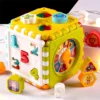Encouraging your baby to roll over is a significant milestone in their early development, fostering muscle strength and coordination. Understanding how to encourage a baby to roll can help parents support this crucial phase quickly and confidently.
From tummy time to interactive play, there are several techniques you can use to motivate your baby to reach this milestone. Rolling over boosts physical growth and enhances cognitive skills, setting a foundation for future movements like crawling and walking.
In this blog post, we’ll explore effective strategies and practical tips for encouraging your baby to roll and ensuring a fun and supportive environment.
Whether you’re a first-time parent or looking to refresh your knowledge, our comprehensive guide will provide all the insights needed to help your baby roll over and develop their mobility skills with joy and enthusiasm.
How to Encourage Your Baby to Roll?
It’s exciting times in the baby’s growth—the encouragement to make a baby roll over. Endowed with these tips, you can make your baby roll:
1. Belleh Tummy Time: Do regular tummy time once your baby is ready—about 3 to 4 weeks old. Begin with minutes and increase the duration with time. Tummy time strengthens the neck, shoulders, arm, and back muscles that all come into play when rolling over.
2. Engage and Motivate: Keep your baby interested in his toys. Place one of his toys a little out of reach during tummy time to encourage him to stretch and move towards the toy, which, over time, might result in a roll.
3. Show How It’s Done: Gently roll your baby from back to tummy and tummy to back. This will help him feel the action and try to do it himself.
4. Encourage Movement: Place toys at their side when they are lying on their backs to give them a reason to turn their necks and stretch out to retrieve them. This will help them shift their weight and eventually roll over.
5. Limit Time in Carriers and Bouncers: While carriers and bouncers can be convenient, babies should have plenty of floor time to develop the proficient muscles that will enable them to move quickly.
6. Cheer Attempts: Always smile, clap, and give loads of positive reinforcement when your baby attempts to roll, even if they don’t fully succeed.
7. Check the Surface: For practice, use a firm, flat surface. Soft or uneven surfaces are hard on babies, who must move uniquely to achieve a roll.
8. Watch for Readiness: Every baby is different and progresses at their rate. While many babies can roll over by 6 months, some take a little longer. Keep calm and keep on encouraging.
By providing ample opportunities and encouragement to move around, you will set your baby up to confidently overcome this and all the other developmental milestones in a supportive, nurturing way.
Ensuring a Safe Environment For Baby-Rolling
Ensure a safe and conducive environment for your baby. Here are critical steps for safety while he learns and practices the skill further:
1. Choosing the Right Space
Choose an ample, open space where your baby has enough room to move around without bumping into furniture or other hazards.
Place him on a firm but soft surface—a clean blanket or even a play mat on the floor will do. Just remember to make sure it’s flat so there won’t be slopes that will touch your baby’s rolling efforts.
2. Remove Potential Hazards
Observe the playing area occasionally for small objects that can cause choking, sharp edges, and complex objects into which your baby may roll and hurt him.
Observe that the place is accessible from stairs, heaters, or other danger zones. Use baby gates or barriers as necessary to restrict access to dangerous areas.
3. Keep a Watch Constantly
Supervision is the key. Never leave your baby unattended during playtime. Being present allows the parent to ensure that if the baby faces any hurdles while trying to execute the new movements, someone will be around to help them out, keeping them safe.
Talk, sing, or play with the baby as they work on rolling to keep them interested. This would enhance their comfort level and confidence and keep them motivated.
4. Encourage Exploration
Allow the baby to move and experiment in your prepared, safe area. Avoid restrictive clothing or tight swaddles that might interfere with their independent opportunity to practice rolling.
Put some stuff with bright colors or other visually stimulating toys and objects around to capture your baby’s interest from the sides so he/she learns to turn his/her head and later his/her body to make possessions of these things.
5. Routine Safety Updates
As your baby grows and becomes mobile, so should the play area, getting updates to accommodate advancing skills and increased ranges of motion.
Retain a regular review of the environment’s safety as your baby masters roll and then go on to crawling and sitting—a stage that will present different challenges for you to make further modifications in the area.
Focusing only on these safety measures provides your baby with a secure and supportive environment for physical growth. It puts your mind at ease as he reaches and conquers this milestone.
Exercises to Strengthen Baby’s Muscles
You want to help your baby develop muscles for rollover. Here are some exercises and activities to do that will strengthen those muscle groups:
1. Happy Baby Pose: This version of a yoga pose is a baby version. Lie your baby on their back and take his or her feet in your hands, rocking them gently backward and forward. This stretch can help open up the hips and aid digestion.
2. Downward-facing Dog: This pose is great because it’s easy and promotes flexibility, motor skills, and general well-being. Place your baby’s hands on the floor, have them lift their buttocks in the air, and have some fun boosting their physical development and mood.
3. Butterfly Twist: Place your baby on his back and bring the soles of the feet together, making a butterfly. Gently squeeze their feet towards their tummy while encouraging them to open their arms sideways. This activity supports hip flexibility and core strength.
4. Hold the Finger: This exercise will build strength in your baby’s arms, shoulders, core, and back and develop his upper body strength and grasp reflex.
5. Tummy Time: Help your baby lie on his belly, which helps build up neck and upper body strength. The tummy is one of the most vital exercises for gaining core stability and developing motor skills.
6. Cycle Away: Gently cycle their legs to release gas trouble and work the abdominal muscles, legs, hips, and knees. Cycling exercises help develop coordination and leg strength.
Remember that all exercises should be done safely, meaning your baby is having a good time. Safety is the priority, coupled with modifying moves according to the baby’s comfort and pace of development.
Recognizing and Overcoming Challenges in Baby’s Rolling Development
While babies learn to roll, they may face some obstacles in accomplishing it. Understanding the issues and how to circumvent them can go a long way toward your baby’s development.
- Neck Strength: Rolling requires much neck strength. If your baby seems to have difficulty holding the head up during their tummy time, start with concise sessions and build up the time slowly. Place bright-colored toys or even mirrors in front of them to motivate them towards lifting.
- Asymmetry: Babies usually prefer to roll in one direction. To ensure balanced development of rolling muscles and overall coordination, encourage them to roll both ways. Place toys on the less preferred side to encourage reaching and rolling towards that side.
- Fear or Discomfort: Some babies are concerned about rolling, and this concern can hold them back. Make them feel safe with pillows or blankets around them when they practice. Reassure them and sit close by to let them feel secure.
- Coordination: Rolling involves coordinating several movements. Assist your ET in guiding their hips and shoulders for tummy time. Slowly withdraw your support as they become more confident and learn how to move.
- Clothing and Nappies: Loose-fitting clothing or tight nappies may inhibit your baby’s movement, especially when rolling quickly. Dress them in comfortable onesies with good stretch that are loose enough not to restrict their movement and will make it easier for them to roll around.
Keep in mind that every baby will do things in its own time. Celebrate the little steps of progress and provide a warm, loving environment to help grow and develop. By thoughtfully attending to these challenges, you can easily ensure your baby rolls.
What to Do After Your Baby Learns to Roll?
Rolling over is a significant milestone in a baby’s life and often signifies the first time a baby becomes mobile. Though most babies start rolling from the tummy to back as early as 3 months of age, one should need to realize that each baby develops differently. Below are ways to help your baby develop these kinds of skills:
1. Tummy Time
Provide your baby with as much tummy time as possible, as it will help strengthen the muscles required to roll over. Lay your baby on a play mat or blanket on the floor and let them play, developing the neck, back, and shoulder muscles.
2. Engage with Toys
Place toys slightly out of reach during belly time, which can motivate your baby to roll toward them. Accompany this activity with songs and shaking toys, and lying down next to your baby may excite tummy time.
3. Cheer the Efforts
Positive reinforcement is very encouraging for your baby to keep practicing rolling. Applaud and cheer when they reach for toys or rock their body during tummy time. It boosts their confidence and motivates them to keep trying.
4. Safety First
The security strap of the changing table should also have your hand always ready there for extra security where your baby is concerned. Never leave your baby alone on tables or countertops and other places that might be dangerously alluring. At the same time, the area should be rid of possible choking objects and small items of interest.
Every baby does things independently, so it requires patience and encouragement. If rolling has not been achieved by 6 months, this should be discussed with the pediatrician. For a child, rolling is a prerequisite to other motor skill achievements. With the right encouragement and support, your little one will soon move.
Final Words
Encouraging your baby to roll over is a rewarding journey that requires patience, consistency, and a lot of enthusiasm. Daily tummy time, engaging toys, and plenty of praise are some ways through which you will be able to help in the physical development of your baby.
Every baby develops differently; it’s essential to appreciate the small things and be patient. Knowing how to encourage your baby to roll means setting up a safe, fun environment that instills confidence in new exploration.
Remember that regular practice and gentle encouragement are the keys to helping your baby master this vital milestone. Use the following tips with a great deal of added love; before long, you’ll have your baby rolling confidently. It’s a journey; enjoy it and watch your baby get stronger and more coordinated with each passing day.









